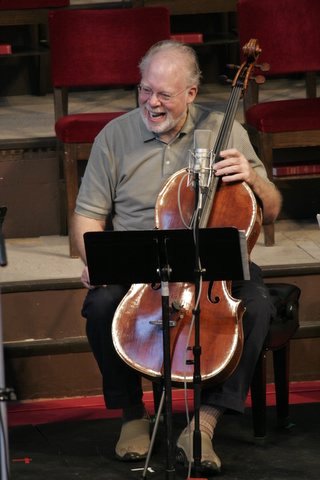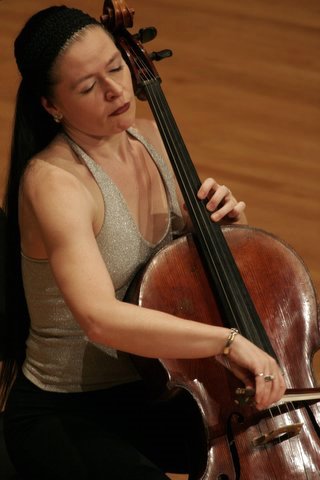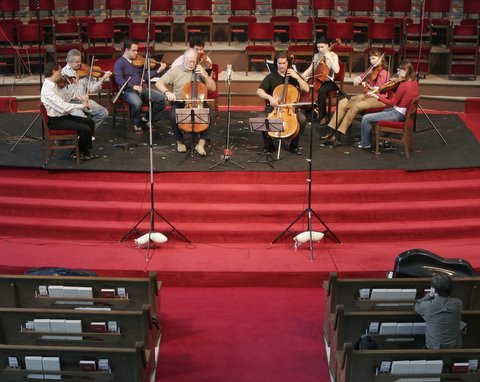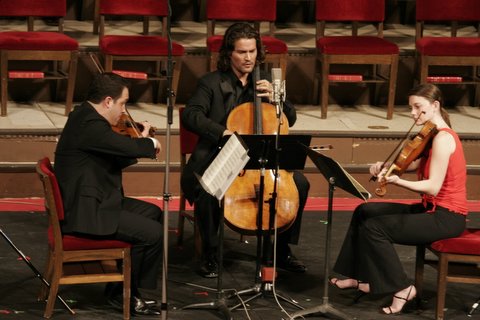
Lynn Harrell
by Tim Janof
Given the drama that led up to this concert, which featured cellists Lynn Harrell, Zuill Bailey, and Shauna Rolston, it is a testament to the professionalism of each and every musician that the concert was a brilliant success. Dropped recording equipment, struggles with balancing work and family, a critically ill baby, and cracked instruments provided an undercurrent of hair-trigger tension that, if released, could have caused the performers to scatter in despair. Those of us who were not in the center of one of these storms found ourselves treading very lightly so as to avoid being the catalyst for the unraveling of this special event.

Zuill Bailey kindly allowed me full access to the various rehearsals, recording sessions, meals, and parties. In addition to the cellists mentioned above, it was a privilege to get to know violinists Gil Morgenstern, Helen Nightengale (Harrell's wife), Giora Schmidt, Guillermo Figueroa, violists Kirsten Johnson and Stephanie Schweigart, and pianist Awadagin Pratt, all excellent musicians and thoroughly delightful people.
Violinist Giora Schmidt is a protégé of Itzhak Perlman and serves as Perlman's teaching assistant at Juilliard. He is also in a piano trio with Navah Perlman (Itzhak's daughter) and Zuill Bailey. Though still in his early twenties, Schmidt has an engaging presence on stage and a style of playing that is reminiscent of his teacher. I asked Schmidt about his mentor's teaching approach and he said that Perlman encouraged the use of lots of vibrato and emphasized the importance of projecting to the back rows of a concert hall. Perlman is not that interested in historical performance practice issues, but he certainly doesn't discourage his students from delving into such matters. Schmidt showed his deep respect for his teacher by always referring to him as "Mr. Perlman."
Schmidt also studied with the late great violin pedagogue Dorothy DeLay, whose former students include Itzhak Perlman, Midori, and others. He described DeLay's well-known lack of punctuality when teaching, somewhat affectionately known as being "DeLayed" by the students who languished for hours outside her studio door. Schmidt recalled showing up for his lesson on time and her not popping her head out of the door until two hours later. Given that there were others who had already been waiting much longer than him, he assumed that he still had many hours to wait. Instead, she asked him to come in next, which was a sign that she liked him.

Violinist Guillermo Figueroa, brother of Raphael, principal cellist of the Metropolitan Opera Orchestra, is originally from Puerto Rico, where he had the opportunity to study with Pablo Casals. His experience with Casals was not particularly satisfying, since Casals' insistence on repeating a phrase endlessly until it was exactly what he was looking for made Figueroa feel more like a machine than an artist.
Violist Kirsten Johnson, who's a regular at El Paso Pro Musica, had a baby recently. She takes her child with her around the country for her various concerts, so she struggles with finding babysitters wherever she goes. The strain of this endless balancing act between family and a demanding career on the road was apparent. She is now pondering auditioning for a more stable orchestra job.
Shauna Rolston is quite a vivacious personality and this comes through in her playing, which is fiery and animated. Even when playing bass lines, she seems to imbue each note with meaning. She typically plays with one leg outstretched, as if trying to slide a dropped quarter back her way, and with her head thrust forward, as if making sure she doesn't miss a single nuance in the score or in her colleagues' performance. I found myself looking passed Zuill Bailey and Lynn Harrell as they played the Vivaldi Double in order to see what Rolston was doing with the tutti cello part. I wish my plane had arrived on time so that I could have heard her play the Shostakovich Sonata, which was "spine-tingling" according to one audience member. She is an extremely engaging performer.

Stephanie Schweigert, the local violin and viola professor, joined Kirsten Johnson in the larger ensembles when an extra viola was needed. She is a fine player in her own right, but because of her quiet demeanor, I couldn't help but wonder if she felt intimidated by the illustrious group of visiting musicians. It was striking how joyous and loving she suddenly became when her students came backstage to see her after the concert.
Grammy winning producer Adam Abeshouse recorded the rehearsals and the concert. As he wheeled his equipment into the hall for the first rehearsal, the strap broke on his practically new case, which contained thousands of dollars worth of recording equipment. As one who frets about the tiniest details for a living, such as extraneous noises from that damn lawn mower outside the hall and slightly out of tune notes, and as one who gets migraines if he eats something from an inordinately long list of no-no's, one can imagine his eye-popping terror as he tested his equipment to make sure it all worked. Everything was fine. Crisis averted.

The life of a recording engineer is not easy. In addition to worrying about equipment failure, he must note precisely where each musician and microphone sits so that the sound is the same from session to session. This is important because he may made need to splice takes from different sessions when producing the recording that is ultimately released. He ensures this consistency by placing pieces of tape ("spikes") on the floor that mark the position of each chair and microphone. This system works beautifully as long as a helpful stagehand doesn't decide to clean up the spikes after a rehearsal, which happened the first day. Though outwardly calm, one could sense Abeshouse's inner heavy sighs as he did his best to recreate the original layout from memory.
A recording engineer must also be very sensitive to the musicians. Abeshouse, who's also a professional violinist, has a particular advantage because he knows what recording sessions are like from a musician's standpoint. Playing the same phrase or movement over and over again is tiring, so Abeshouse is always gauging the emotional state and energy level of the musicians, which can also be affected by whatever's going on in a musician's personal life. He has to know when to ask for another take and how to delicately point out questionable intonation and shaky ensemble moments.
It was enlightening talking to Abeshouse about his techniques for recording various ensembles. His results are incredible, as was evidenced by Lynn Harrell's rapture as he listened to the playback on the headphones. For cello sonatas, for example, Abeshouse recommends that the cellist sit in the nook of the piano. Some cellists prefer to sit stage right of the pianist, since they often feel overwhelmed by the piano when sitting in the nook. When Abeshouse encounters resistance to his recommendation, he samples the playing with both seating arrangements, which invariably convinces the cellist to sit in the nook for the recording session. The results are far superior.
Zuill Bailey is the Artistic Director of El Paso Pro Musica. It's difficult enough to perform in these events, so dealing with the various administrative responsibilities in addition would surely drive most people to distraction, but not Bailey, who takes it all in stride. The Artistic Director is responsible for developing programs for concerts, recruiting musicians, dealing with the various personalities and needs of the musicians, and being the face of the organization for the public.
One audience member came up to Zuill recently and berated him for amplifying the concert. "Microphones are meant for recording, not amplification! You ruined my entire concert experience!" Zuill, taken aback by the lengthy intensity of the remarks, did his best to calmly explain that the concert was in fact NOT amplified, and that, if the sound levels were in fact higher, it may be that he was listening to a Stradivarius, Montagnana, and Gofriller!

Perhaps the looming issue over the entire weekend was the fact that Lynn Harrell's baby had contracted a dangerous virus. He and his wife were in and out of the hospital several times with their child, and they were on the phone with the doctor constantly. As one might expect, the Harrells were suffering from severe sleep deprivation as they took care of their baby through several nights. The rest of us walked on eggshells the entire time, trying not to do or say anything that might send them packing. Remarkably, the Harrells showed true grace under such excruciating circumstances. They arrived at rehearsals on time and were always cheerful and professional.
The next crisis occurred on the day of the concert. The dry El Paso air caused the seams to open in both Bailey's and Harrell's cellos. Bailey's were manageable, though there was a buzz, but the lower left bout of Harrell's Montagnana had come apart so far that one could almost fit a saucer through the seam that had opened. It was impossible to look at the cello without cringing. Harrell, the consummate professional, did what he could to ensure that his cello troubles didn't interfere with the rehearsal. He had to keep re-tuning because the bridge continued to sink lower and lower as the back came more and more undone. When Harrell explained the situation to the group, the irrepressible Guillermo Figueroa said, "Next time bring your good cello!" Kirsten Johnson later said, "At least there's no buzz!"
As if this wasn't enough, there is no luthier in the El Paso area that one could bring a Montagnana to for repairs, so the best solution was for Harrell's second cello, which he keeps in his studio in Houston, to be flown in. Harrell's assistant arrived at 3pm that day, again, the day of the concert, and Harrell's Montagnana was whisked away to Houston for repairs.
Changing instruments is certainly not something one wants to do at the last minute. Harrell had never performed on the instrument, so he wasn't as familiar with it and he had to play a little carefully. Abeshouse wasn't thrilled by the switch in instruments either because the takes from the rehearsals sound different from the concert. If a recording is released, it will be interesting to listen for differing cello sounds from Harrell.
Lynn Harrell is in many ways a cellist's cellist. He seems to have no technical limitations whatsoever. If he can imagine it, he can do it. As Zuill said in a pre-concert lecture, the "amazing thing about Lynn Harrell is that he makes what is unbelievably difficult seem absolutely effortless." Part of his illusion of ease is due to his perfectly economical motions when he plays; nothing moves more than it needs to. Harrell said that when he watches himself on video he wishes he would move more because he believes that the current generation of listeners is more visually oriented, but it goes against his training to do so and he can't bring himself to change.
It was interesting to contrast Harrell's degree of movement with Bailey's and Rolston's. Harrell barely moves at all, while Rolston does a lot of head bobbing and leg movement. Bailey is somewhere in the middle.
As I watched Harrell play, I could almost imagine him narrating to himself as he played, "Here's my stunningly perfect upper half martélé � Here's my machine-gun-like spiccato�." At one point Giora Schmidt was so taken aback by Harrell's sparkling spiccato that he lost his place in the rehearsal and the group had to re-start. At times Harrell seemed to be totally engrossed in having fun with his unparalleled bag of cellistic tricks.
One stroke that he seems particularly fond of is a wrist-only detaché. It seemed to scrub a little more than what one hears from a stroke in which the entire arm is engaged, but he clearly likes the sound that is produced, and it certainly gives the impression of harnessed intensity. Even when he played with the utmost delicacy, which he often did, it seemed as if his volcanic power could erupt at any moment. His delight in relaying Michael Rabin's explanation that Rabin plays louder by "pressing with both hands" certainly reinforced this impression.

Harrell also has a very engaging left hand technique, perhaps because it is so quiet and effortless. His hands are unusually large, so there are things he can do that most can't, like comfortably play the half string A with his fourth finger while his first finger is still on E, which he likes to do in the Arpeggione Sonata. His left hand is rarely extended, probably because he doesn't need to, so one gets a clear concept of shifting between blocks of notes as he plays. He also meticulously places notes to ensure they are perfectly in tune.
Harrell has a tremendous interest in the equipment side of things. He has spent a lot of time experimenting with strings and he finally decided on custom-made extra thick Pirastro Olives on the bottom and Eva Pirazzis on the top. He insists on the use of Tartini rosin, the Solo type, not the Symphonic or Silk. Bleached bow hair tends to stretch more than unbleached, so he uses the latter. And he uses a Korg AW-1 clip-on tuner during recording sessions, which allows him to silently pluck his strings and adjust them as needed. There seems to be almost nothing that he hasn't worked out in great detail.
Harrell has some concerns about the music world today. One is that promoters seem less interested in recitals. While he enjoys his many concerto bookings, he'd love to play more than twenty or thirty minutes of music at a time. He also laments the fact that students seem to have much less general musical knowledge than students of earlier generations. He feels that music students should be familiar with all the major works of the major composers by the time they graduate, but he doesn't see this very often anymore.
Harrell loves to talk about music constantly and is an endless source of fascinating musical factoids. He mentioned that the Bach Chaconne may have been written when Bach came home to discover that his wife had died. The Strad that was stolen from Peter Stumpf of the Los Angeles Philharmonic was the one on which the Dvorak Concerto was premiered, which would have made its conversion to a CD cabinet all the more tragic. He once asked Lukas Foss why nobody has completed Bach's Art of the Fugue, to which Foss replied defensively, "Well, it's a reverse double fugue, after all�."
Though a quiet person by nature, he also has a side of him that enjoys being the life of the party. He amused (scared?) us with his imitations of various gun and canon sounds, at one point "becoming" an old crotchety cowboy before firing. He also does a heck of a lawn sprinkler impression.
Zuill Bailey, Giora Schmidt, and Kirsten Johnson were slated to play the Dohnanyi Serenade. It was reassuring to watch such high level musicians struggle with the intonation of the third movement, which has those devilish chromatic unison passages. They spent a lot of time doing slow, note by note work as they tried to figure out who the culprit was. It was even more reassuring to learn that the recording with Perlman, Zukerman, and Harrell greatly benefited from, as Harrell said, "thousands of cuts."

Harrell tended to lead the rehearsals in pieces that involved him, though very gently and respectfully. He feels that the second movement of the Mendelssohn Octet is often played too slowly because of fingering difficulties. The movement should be felt in 2, not 6. He'd often used emotional imagery to describe what he was looking for: "We must portray the hesitation of the sadness�. Expressive floating and cloud-like � The idea of the devil is that he does these horrendous things and we need to get that energy�. A little more argumentative...."
Whenever Harrell waxed poetically, violinist Figueroa, who's also a conductor, immediately translated Harrell's message into something very simple, "You mean faster? � You mean shorter? � You mean louder?" Talk about killing a moment�. Figueroa believes that most discussion about music can and should be distilled to very basic messages.
Harrell occasionally referred his time in the Cleveland Orchestra and some "old George Szell tricks." For example, the last four fortissimo notes of the Mendelssohn Octet should be played closer to the bridge "quasi poco ponticello." The scratchiness isn't audible in larger groups, and the results are electrifying! Another trick is to bounce the bow very high in spiccato because the notes ring much more clearly.

If I hadn't known about the events of the last few days, I still would have thought that the playing was gorgeous, but knowing the back-story made the concert all the more remarkable. The musicians walked out on stage and had a great time, as if the stage was their safe place. One could see Harrell's shoulders drop with relief as he finally got to do what he does best and he mesmerized the crowd with absolutely masterful playing. I heard somebody afterwards say, "This is one of the best concerts I've ever been to."

The Dohnanyi Serenade was full of passion, the Couperin was serenely gorgeous, and the Vivaldi Double provided a wonderful opportunity for the audience to hear two generations of cellists play side by side. It was reassuring to know that we will be in good hands with Bailey when Harrell no longer plays. The Mendelssohn Octet then brought the audience to its feet, led with jaw-dropping power and virtuosity by the ordinarily introverted Gil Morgenstern.
The concert brought to mind Janos Starker's notion of professionalism. A professional can deliver a first rate performance even under the most trying of circumstances. One would never have known that Lynn Harrell had barely slept in days, or that he had a sick baby that he ached to return to, or that he was using an unfamiliar cello. One would never have known that Kirsten Johnson missed her child, or that Zuill Bailey was running himself ragged trying to keep the event from unraveling. After all, the audience doesn't know or particularly care about what happens behind the scenes. They pay their money to hear beautiful music.

After the last few days, most mortals would need a few days to recover, but that's not the life of a soloist. Lynn Harrell hopped on a plane the next day to play the Schumann Concerto with the San Francisco Symphony, and Zuill Bailey hopped on another plane to play the Haydn C Major with the Ft. Worth Symphony, where they were expected to deliver yet another world class performance despite being completely drained from the previous few days.
The life of a soloist is grueling. For those who may be tempted to judge a performance too harshly, consider that you have no idea what the musician may have gone through before they walked on stage. They may be performing miracles up there.
(Note: All pictures were taken by Patrick Mullen.)

| Direct correspondence to the appropriate ICS
Staff Webmaster: Eric Hoffman Director: John Michel Copyright © 1995- Internet Cello Society |
|---|